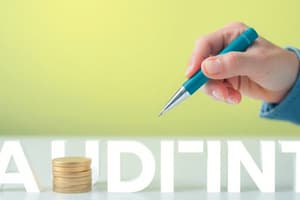Podcast
Questions and Answers
What does ALARA stand for?
What does ALARA stand for?
- All Losses Are Reasonably Avoidable
- As Low As Reasonably Achievable (correct)
- All Risks Are Lessened Accordingly
- Aptly Limit All Risks As Needed
Which risk response strategy involves shifting financial responsibility for losses?
Which risk response strategy involves shifting financial responsibility for losses?
- Transfer (correct)
- Retention
- Avoidance
- Reduction
Which of the following is NOT a tool used for risk identification and analysis?
Which of the following is NOT a tool used for risk identification and analysis?
- Risk Maps
- Cost Benefit Analysis (correct)
- Flowcharts
- Checklists
What does the Domino Theory suggest about accidents?
What does the Domino Theory suggest about accidents?
What is the purpose of a Job Safety Analysis (JSA)?
What is the purpose of a Job Safety Analysis (JSA)?
What is the primary focus of risk-based auditing?
What is the primary focus of risk-based auditing?
Which of the following is NOT a common objective of risk management?
Which of the following is NOT a common objective of risk management?
What role do staff underwriters NOT typically perform?
What role do staff underwriters NOT typically perform?
Which aspect is most crucial in underwriting policy formulation?
Which aspect is most crucial in underwriting policy formulation?
Which of the following best describes moral hazard?
Which of the following best describes moral hazard?
In property application reviews, which information is least relevant?
In property application reviews, which information is least relevant?
What does the process of rating involve?
What does the process of rating involve?
What is included in the 5-S housekeeping technique?
What is included in the 5-S housekeeping technique?
Which of the following is a financial consideration in risk management?
Which of the following is a financial consideration in risk management?
Who implements risk financing techniques?
Who implements risk financing techniques?
What does a combined ratio of less than 100 indicate?
What does a combined ratio of less than 100 indicate?
What is the primary concern for underwriters?
What is the primary concern for underwriters?
What type of reinsurance is concerned with individual loss exposures?
What type of reinsurance is concerned with individual loss exposures?
Which method is used for qualitative risk assessment?
Which method is used for qualitative risk assessment?
What does the Single Loss Expectancy (SLE) formula calculate?
What does the Single Loss Expectancy (SLE) formula calculate?
Which step is NOT part of the EPA Human Health Risk Assessment process?
Which step is NOT part of the EPA Human Health Risk Assessment process?
What is the retention ratio in underwriting?
What is the retention ratio in underwriting?
What does COPE stand for in commercial property underwriting?
What does COPE stand for in commercial property underwriting?
What is the primary purpose of a loss run report?
What is the primary purpose of a loss run report?
How do underwriters analyze fire protection for a property?
How do underwriters analyze fire protection for a property?
What is the difference between public and private fire protection?
What is the difference between public and private fire protection?
Which factor is part of a rating plan for determining insurance premiums?
Which factor is part of a rating plan for determining insurance premiums?
What does the retention ratio measure?
What does the retention ratio measure?
What are nonfinancial measures used for?
What are nonfinancial measures used for?
What is the primary purpose of catastrophe insurance?
What is the primary purpose of catastrophe insurance?
What does retrocession refer to in insurance terms?
What does retrocession refer to in insurance terms?
According to Human Factors Theory, what category does the cause of accidents due to stress fall into?
According to Human Factors Theory, what category does the cause of accidents due to stress fall into?
Who is primarily responsible for conducting an incident investigation?
Who is primarily responsible for conducting an incident investigation?
What is the first step in the Hierarchy of Controls for risk management?
What is the first step in the Hierarchy of Controls for risk management?
What does a Preliminary Hazard Analysis (PHA) primarily focus on?
What does a Preliminary Hazard Analysis (PHA) primarily focus on?
How does inductive reasoning operate in analysis techniques?
How does inductive reasoning operate in analysis techniques?
What is Fault Tree Analysis (FTA) used for?
What is Fault Tree Analysis (FTA) used for?
What defines a hazard in risk assessment?
What defines a hazard in risk assessment?
In risk terminology, what does risk represent?
In risk terminology, what does risk represent?
Flashcards
Risk-Based Auditing
Risk-Based Auditing
Prioritizing internal audit resources to areas posing the highest risk to the organization.
Risk Management
Risk Management
The process of controlling or minimizing potential losses and satisfying customer needs.
Underwriting
Underwriting
An insurer's process for selecting and classifying insureds, setting prices, and managing the overall portfolio.
Staff Underwriters
Staff Underwriters
Signup and view all the flashcards
Underwriting Policy
Underwriting Policy
Signup and view all the flashcards
Rating
Rating
Signup and view all the flashcards
Moral Hazard
Moral Hazard
Signup and view all the flashcards
Rating Plan
Rating Plan
Signup and view all the flashcards
5-S
5-S
Signup and view all the flashcards
Combined Ratio
Combined Ratio
Signup and view all the flashcards
Risk Assessment
Risk Assessment
Signup and view all the flashcards
Reinsurance
Reinsurance
Signup and view all the flashcards
Retention Ratio
Retention Ratio
Signup and view all the flashcards
Hit Ratio
Hit Ratio
Signup and view all the flashcards
Risk Control
Risk Control
Signup and view all the flashcards
Risk Financing
Risk Financing
Signup and view all the flashcards
What is a Loss Run?
What is a Loss Run?
Signup and view all the flashcards
What is a Morale Hazard?
What is a Morale Hazard?
Signup and view all the flashcards
What is a Fire Division?
What is a Fire Division?
Signup and view all the flashcards
What is Public Fire Protection?
What is Public Fire Protection?
Signup and view all the flashcards
What is Private Fire Protection?
What is Private Fire Protection?
Signup and view all the flashcards
How do underwriters evaluate residential risks?
How do underwriters evaluate residential risks?
Signup and view all the flashcards
What is a Rating Plan?
What is a Rating Plan?
Signup and view all the flashcards
What does the Combined Ratio tell us?
What does the Combined Ratio tell us?
Signup and view all the flashcards
What is the Retention Ratio?
What is the Retention Ratio?
Signup and view all the flashcards
What is Risk Assessment?
What is Risk Assessment?
Signup and view all the flashcards
What is Job Safety Analysis (JSA)?
What is Job Safety Analysis (JSA)?
Signup and view all the flashcards
What is the goal of Risk Control Techniques?
What is the goal of Risk Control Techniques?
Signup and view all the flashcards
What is Risk Financing?
What is Risk Financing?
Signup and view all the flashcards
What is the Domino Theory?
What is the Domino Theory?
Signup and view all the flashcards
Catastrophe Insurance
Catastrophe Insurance
Signup and view all the flashcards
Retrocession
Retrocession
Signup and view all the flashcards
Human Factors Theory
Human Factors Theory
Signup and view all the flashcards
Vicarious Liability
Vicarious Liability
Signup and view all the flashcards
Hazard Analysis
Hazard Analysis
Signup and view all the flashcards
Inductive Reasoning
Inductive Reasoning
Signup and view all the flashcards
Deductive Reasoning
Deductive Reasoning
Signup and view all the flashcards
Fault Tree Analysis (FTA)
Fault Tree Analysis (FTA)
Signup and view all the flashcards
Incident
Incident
Signup and view all the flashcards
Study Notes
Risk-Based Auditing
- Risk-based auditing prioritizes using an organization's limited internal audit resources in areas with the highest risk.
- It focuses on auditing according to business objectives, considering materiality of risk, and identifying threats to business goals.
Risk Management and Organizational Alignment
- Risk management provides insurance and risk solutions for controlling or limiting losses.
- Common objectives include balancing risk and reward, supporting decision-making, achieving goals (like tolerable uncertainty), legal compliance, and social responsibility.
Underwriting
- Underwriting helps insurers maintain a growing, profitable book of business.
- It minimizes adverse selection, ensuring adequate reserves, and enforcing underwriting guidelines.
- Underwriters select insureds, classify and price accounts, recommend coverage, and support the achievement of marketing objectives.
Staff Underwriters
- Staff underwriters conduct market research, develop underwriting policies, review guidelines, evaluate loss experience, develop coverage forms, review rates, handle complex accounts, and perform underwriting audits.
Underwriting Policy
- Underwriting policy guides individual and aggregate policy selection, supporting insurer mission statements.
Essential Knowledge for Underwriters
- Successful underwriters possess knowledge of insurance principles, loss exposures, pricing, insurance rates, loss analysis, and internal and external information sources.
Rating
- Rating involves applying applicable rates and plans to exposures and calculating premiums.
Moral Hazard
- Moral hazard increases the likelihood of intentional loss exaggeration.
Property Application
- Underwriters review property applications, including loss history, essential elements, and property values.
Supplemental Information
- Supplemental information, like risk management programs, financial statements, risk control reports, and valuation guides, helps assess property accounts.
COPE and Loss Run
- COPE elements (construction, occupancy, protection, and external exposures) are analyzed by commercial property underwriters.
- Loss runs detail an insured's claims history over a specific period.
Morale Hazard
- Morale hazard occurs due to carelessness or indifference, increasing loss frequency or severity.
Fire Protection and Division
- Underwriters analyze loss exposures from neighboring properties and surrounding areas.
- Fire divisions are sections of a structure well-protected from fire spread to other sections.
Public and Private Fire Protection
- Public fire protection involves government-provided resources for fire protection.
- Private fire protection involves measures property owners take to protect assets from fire.
Residential and Occupational Loss Exposures
- Underwriters evaluate residential loss exposures, considering hazards that increase liability from guests.
- Personal insurance applications consider occupation to determine potential loss frequency and severity.
Rating Plan
- Rating plans detail criteria for exposure base, exposure units, and premium determination.
Combined Ratio
- A combined ratio below 100 indicates underwriting profit.
- A combined ratio above 100 suggests underwriting loss.
Nonfinancial Measures
- Nonfinancial measures track underwriting results, including selection, pricing, product mix, retention ratio, hit ratio, customer service, and premium volume.
Retention Ratio
- Retention ratio is the percentage of expiring policies an insurer renews.
- Renewing policies is usually more profitable than acquiring new ones.
Hit Ratio
- Hit ratio measures underwriter success in meeting sales goals.
Physical Controls
- Physical controls limit access to protected areas (e.g., locks, fences).
Technical Controls
- Technical controls (logical controls) secure computing environments (e.g., operating systems, firewalls).
Directive Control
- Directive controls specify expected employee behavior via policies and guidelines.
Deterrent Control
- Deterrent controls discourage security violations due to effort or consequences (e.g., CCTV).
Preventative Control
- Preventative controls stop security incidents (e.g., background checks).
Compensating Control
- Compensating controls mitigate risk when basic protection isn't sufficient.
Detective Control
- Detective controls identify security violations.
Corrective Control
- Corrective controls address security violations.
Hazard
- A hazard is a condition or activity potentially causing harm.
Risk
- Risk is the chance of an injury, loss, or hazard occurrence.
Incident
- An incident involves a work-related injury, illness, or fatality.
Risk Response Strategies
- Risk Response Strategies include avoidance, transfer, retention, and reduction.
Risk Assessment
- Risk assessment comprises risk identification, analysis, and evaluation.
ALARA/ALARP
- ALARA (As Low As Reasonably Achievable) or ALARP (As Low As Reasonably Practical) aims to reduce risk.
Loss Control Measures
- Loss control measures, like hazcom training and machine guards, reduce accidents.
Domino Theory
- Domino Theory states that accidents are caused by chains of events.
Petersen's Accident/Incident Theory
- Accident causes often involve human error and system failures.
Risk Analysis vs. Risk Management
- Risk analysis quantifies risk. Risk management determines an acceptable level.
Hazard Analysis Categories
- Hazard analysis categories include three levels.
Environmental Issues
- Environmental issues like stress, inherent properties, and equipment failures can create workplace risk.
Primary Methods for Reducing Accidents
- Prevention and cost reduction methods reduce accidents.
Objectives of Risk Management
- Business objectives include reducing anxiety, meeting corporate responsibilities, and sustaining growth.
Poka-Yoke
- Poka-yoke is a lean manufacturing technique, preventing errors through preventative design.
Kaizen/5-S
- Kaizen is continuous improvement. 5-S is a housekeeping technique for effective organization.
Risk Management Techniques
- Risk control aims to reduce or prevent losses. Risk financing involves funding for losses.
Risk Management
- Risk management analysis considers financial and non-financial factors.
Implementing Risk Management Techniques
- Implement risk financing techniques with professionals. Implement risk control techniques with operations managers to involve communication and training.
Insurance Ratings
- Rating plans use criteria for exposure base, exposure units, and premiums.
- A combined ratio below 100 indicates profit. Above 100, loss.
Underwriting
- Underwriting elements include retention ratio, hit ratios, and policies with limits, deductibles.
- Loss severity is prioritized over frequency.
Reinsurance
- Reinsurance involves transferring risk to another insurer.
Underwriting Guidelines
- Guidelines define an insurer's willingness to insure specific accounts.
Qualitative and Quantitative Risk Assessment
- Qualitative assessment uses categorizations to estimate risk; quantitative assessment uses numerical estimates.
Risk Assessment Formulas
- ARO calculates the annual rate of occurrence of a risk. EF assesses the potential loss percentage.
EPA Human Health Risk Assessment
- Assessing human health risks involves four steps, including hazard identification, dose-response assessment, exposure assessment, and risk characterization.
Underwriting Elements
- Underwriters often require higher liability limits and deductibles, and consider underlying insurance.
Loss Analysis
- Loss analysis involves understanding an insured's operations to identify risks and assess if loss experience is appropriate.
Risk Definition and Analysis
- Risk combines severity and probability.
- Residual risk is risk remaining after treatment.
Risk Management Frameworks
- Enterprise Risk Management (ERM) coordinates risk management from diverse sources.
Predictive Modeling
- Predictive modeling uses historical data for future outcomes.
Catastrophe Models
- Catastrophe models estimate potential losses from catastrophic events.
Insurance Types
- Catastrophe insurance covers low-probability, high-cost events.
- Reinsurance transfers risk from one insurer to another.
- Retrocession is retained risk by an insurer.
Human Factors Theory
- Human error is categorized as overload, inappropriate response, and inappropriate activity.
Vicarious Liability
- Vicarious liability links responsibility to injuries caused by others.
- Investigate actions and evaluate loss exposures.
Hazard Analysis
- Hazard Analysis identifies risks and recommends reductions.
- Preliminary Hazard Analysis (PHA) is a common risk identification technique.
Inductive and Deductive Reasoning
- Deductive reasoning (general to specific), and inductive (specific to general) apply to different safety analysis techniques.
Fault Tree Analysis (FTA)
- FTA evaluates an undesirable outcome to its possible causes.
Hazard and Risk
- A hazard is a potential harm; risk is the probability of harm.
Incident and Risk Response Strategies
- An incident refers to a work-related injury or loss.
- Risk response strategies include avoiding, transferring, retaining, or reducing risk.
Risk Assessment and Evaluation
- Risk assessment is an overall process of identifying, analyzing, and evaluating risk.
Loss Control Measures and Domino Theory
- Loss control measures (e.g., training, safety equipment) prevent accidents.
- The Domino Theory explains accidents by a series of contributing events.
Other Risk Management Concepts
- SWOT analysis evaluates business and strategy risks. Job safety analysis identifies risks at each step of a process.
Risk Management Program
- Risk management programs should adapt to new risks and developments.
Risk Identification and Analysis
- Identifying risks involves various tools (loss histories, checklists).
Risk Treatment Techniques
- Techniques like risk avoidance, or risk modification can reduce exposures.
Risk Control Techniques
- Risk control techniques like avoiding or modifying risks can reduce loss frequency or severity.
Risk Financing Techniques
- Risk financing techniques include retaining or transferring risk to another party via a contract.
Selecting Risk Management Techniques
- Selecting appropriate techniques supports and reinforces personal objectives.
Personal and Advertising Injury Exposures
- Personal and advertising injuries involve wrongful actions leading to liability.
Medical Payments Loss Exposures
- Medical payments cover medical costs resulting from incidents on the property.
Real Property (Realty)
- Real property includes land, structures permanently attached, and any growth on that land.
Ethical Principles
- Ethical principles for risk management involve fairness, confidentiality, due professional care, independence, evidence-based approach, and a risk-based approach.
Pure Risk
- Pure risk describes a situation with only potential loss and no chance of gain.
Other Concepts
- Whole-person theory considers a person's overall capabilities after an incident.
- Indemnity replaces lost wages after an injury.
- Wage loss theory evaluates financial impact of losses.
- Residual risk is remaining risk after treatment.
- A Pareto analysis charts the relative importance of items in order of severity or frequency.
Studying That Suits You
Use AI to generate personalized quizzes and flashcards to suit your learning preferences.




